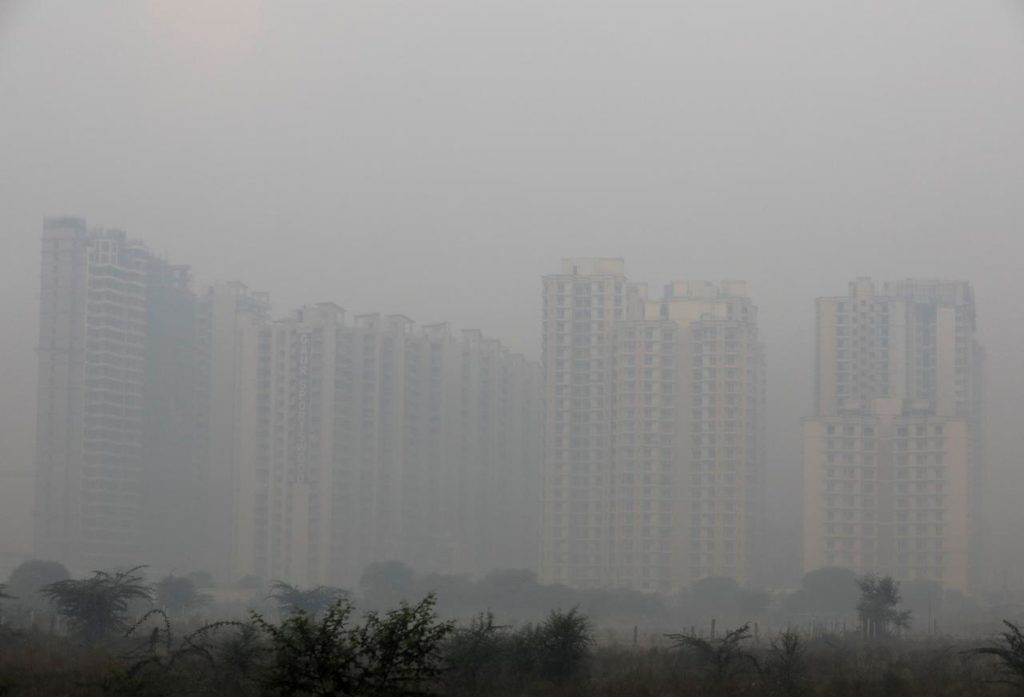What’s Inside Northern India’s Winter Smog?
Jan 10, 2024 | Pratirodh Bureau
FILE PHOTO: Buildings are engulfed in fog in Noida on the outskirts of New Delhi
Every January, millions of people across India’s Ganges plain find themselves caught in fog — cloud at ground level.
This cloud then mixes with smoke from open fires lit for heating and cooking and vehicle exhaust, turning the fog into a toxic smog that shrouds the country for weeks.
Besides air quality deterioration, it also reduces visibility, disrupts travel as well as the transportation of goods and can even lead to loss of life. The livelihood of millions of people is affected.
The Indian meteorological department defines a fog event to have occurred when visibility reduces to 1000 metres or less.
In the last 40 years, there has been a five-fold increase in the number of poor visibility days in the Indo-Gangetic Plain.
Like all clouds, the main ingredient of fog is water vapour.
Pollutants in the air in the form of microscopic aerosol particles soak up the water vapour and grow to larger droplets blocking solar light by scattering and absorption.
The high aerosol load reduces radiation from reaching the surface, thereby cooling the ground. At the same time, it warms the layers of the atmosphere above the ground, which in turn lowers the “boundary layer height”.
The “boundary layer height” is like a lid over the lower atmospheric layer into which surface emitted and chemically formed pollutants accumulate.
During summer, the height of this lid over the Indo-Gangetic Plain reaches 2000m or more during the daytime and is still several hundreds of metres high at night.
By winter, however, the height of this lid drops several hundred metres. The same air pollution emissions then accumulate and build up within a much smaller container (that is reduced in volume by as much as five times compared to Summer), resulting in higher air pollutant concentrations.
These further aggravate the duration and intensity of the fog.
This is what causes the visibility to decrease, preventing airplanes from landing and slowing down cars and trains.
Economic losses due to these disruptions easily exceed several hundred million rupees every year.
During November, paddy stubble burning adds significantly to the aerosol burden and pollution.
By late December and early January, the extra open fires for cooking and heating by the vast population who cannot afford cleaner technologies, become the major sources of air pollutants.
The lower temperatures that accompany fog episodes trigger more open burning for heating — scenes of people huddled around these small fires are a common sight across the region’s cities and villages during winter.
These open fires end up releasing more aerosol particles, which can prolong the fog event by providing additional particles that can soak up the water vapour and swell to produce more fog droplets.
Such open fire emissions release copious amounts of both gaseous and aerosol pollutants into the air, a noxious cocktail that, when combined with the aerosol–radiation feedback, strengthens the spread of the thick blanket of smog over the region.
Several toxic chemicals like isocyanic acid and benzene, a human carcinogen, are also released.
While these factors significantly affect the fog lifecycle, without large scale regional availability of moisture, they would only result in air pollution aggravation, as in the November cycle.
What distinguishes the late December and early January periods from November, is the influx of water vapour near the ground through the rainfall induced by the extra-tropical weather system known as Western Disturbance.
This moistens the ground. The irrigation of the winter wheat crop provides even more water for evaporation, in addition to the existing natural water bodies (ponds, rivers and canals) present in the region.
Further, the occurrence of “atmospheric rivers” as a result of moisture transported from the Arabian Sea, also adds to the water vapour in the air during winter.
Over the past few decades, there has been a documented increase in fog frequency, persistence, and intensity over the region.
The most intense fog events predominantly occur from midnight to 8am.
This is when wind speeds are low, promoting stagnant conditions for accumulation. Surface water vapour easily condenses through the night-time cooling of the ground. The ground air cools to its dew point – thereby condensing the water vapour in it to liquid droplets.
Dissipation of the fog occurs during daytime due to surface warming and when wind speeds pick up. However, this may not happen for prolonged periods.
This is the most common type of fog that occurs over the Indo-Gangetic Plain and in scientific parlance is referred to as “radiation-fog”.
Research such as the winter fog experiments program led by the Indian Institute of Tropical Meteorology and several other national research institutes in India, are attempting to find out more about the phenomenon.
Right now, there are still more “unknowns” than “knowns”.
Further scientific efforts are needed to design focused regional field studies with comprehensive chemical and meteorological observations to unravel the chemistry of fog. This will help with improved fog forecasts that can alert citizens with more accurate and timely warnings.
As for improving air quality and minimising fog, a serious investigation of prevalent agricultural practices, in particular for irrigation and handling of crop residue, and preventing open fires will help. This can be done by providing access to cleaner energy technologies for heating and cooking along with better waste disposal.
This would be a win-win for air quality and improved quality of life for the millions that inhabit this dynamic developing region of the world.
(Originally published under Creative Commons by 360info™. Read the original article here)
